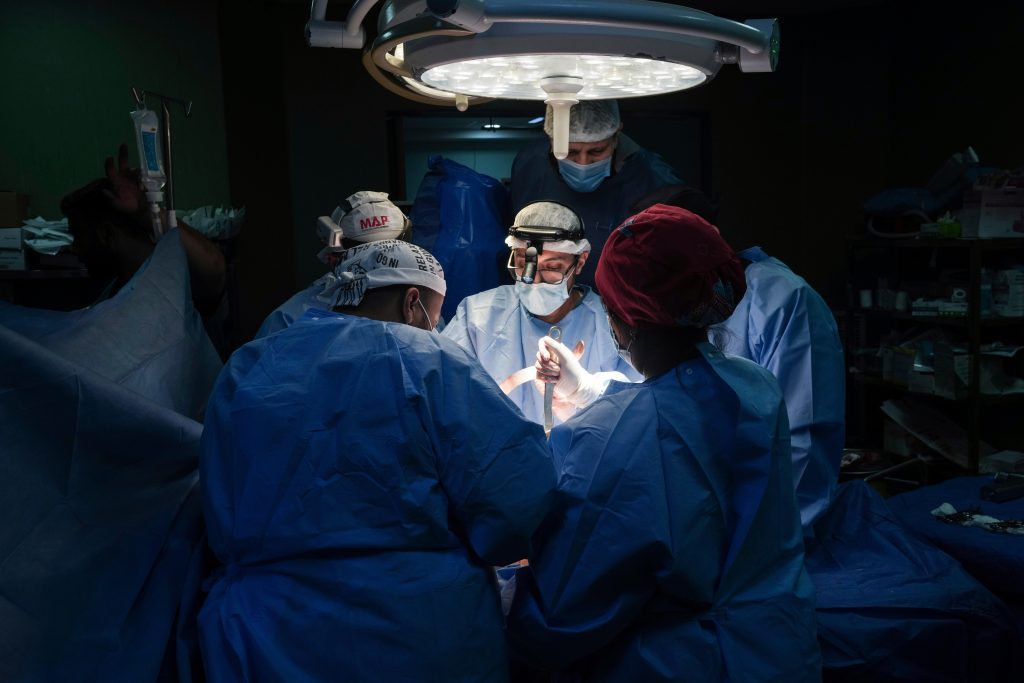By WAFAA SHURAFA and KAREEM CHEHAYEB (Associated Press)
DEIR AL-BALAH, Gaza (AP) — A group of international doctors visited a hospital in central Gaza and were prepared for the worst. However, they were still shocked by the terrible impact that Israel’s war against Hamas is having on Palestinian children.
A young child died from a brain injury caused by an Israeli strike that fractured his skull. His cousin, a baby, is still fighting for her life after part of her face was blown off by the same strike.
An unrelated 10-year-old boy cried out in pain for his parents, not realizing that they had been killed in the strike. Next to him was his sister, whom he did not recognize because burns covered almost her entire body.
Tanya Haj-Hassan, a pediatric intensive-care doctor from Jordan, described these heartbreaking casualties to The Associated Press after a 10-hour overnight shift at Al-Aqsa Martyrs Hospital in the town of Deir al-Balah.
Haj-Hassan, who has extensive experience in Gaza and regularly speaks out about the war’s devastating effects, was part of a team that recently finished a two-week stint there.
After nearly six months of war, Gaza’s health sector has been severely damaged. Roughly a dozen of Gaza’s 36 hospitals are only partially functional. The rest have either closed or are barely functioning due to running out of fuel and medicine, being surrounded and raided by Israeli troops, or being damaged in fighting.
This means hospitals like Al-Aqsa Martyrs are left caring for a large number of patients with limited supplies and staff. The majority of its intensive care unit beds are filled with children, including infants wrapped in bandages and wearing oxygen masks.
“I spend most of my time here resuscitating children,” Haj-Hassan said after a recent shift. “What does that tell you about every other hospital in the Gaza Strip?”
A different team of international doctors stayed at a nearby guesthouse while working at Al-Aqsa Martyrs in January. However, due to a recent surge of Israeli strikes nearby, Haj-Hassan and her co-workers stayed in the hospital itself.
This gave them a very clear view of the pressure the hospital is under as the number of patients continues to rise, said Arvind Das, the team leader in Gaza for the International Rescue Committee. His organization and Medical Aid for Palestinians organized the visit by Haj-Hassan and others.
Mustafa Abu Qassim, a nurse from Jordan who was part of the visiting team, said he was shocked by the overcrowding.
“When we look for patients, there are no rooms,” he said. “They are in the corridors on a bed, a mattress, or on a blanket on the floor.”
Before the war, the hospital had a capacity of around 160 beds, according to the World Health Organization. Now there are some 800 patients, yet many of the hospital’s 120 staff members are no longer able to come to work.
Health care workers face the same daily struggle as others in Gaza in finding food for their families and trying to ensure some safety for them. Many bring their children with them to the hospital to keep them close, Abu Qassim said.
He said it's very awful.
Many people forced out of their homes by the war are also staying on the hospital grounds, hoping it will be safe. Hospitals have special protections under international law, but those protections can be taken away if fighters use them for military purposes.
Israel has claimed that hospitals are used as command centers, weapons storage facilities, and hiding places for Hamas, but has shown little visual evidence. Hamas has denied the accusations. Israel has been carrying out a large operation in Gaza’s largest hospital, Shifa, for the past week.
Israeli soldiers have not attacked or surrounded Al-Aqsa Martyrs Hospital but have struck nearby areas, sometimes hitting close to the hospital. In January, many doctors, patients, and displaced Palestinians fled the hospital after a series of strikes.
Israel’s heavy bombing and attack in Gaza have killed over 32,000 Palestinians and injured nearly 75,000 more in the territory of 2.3 million people, according to Gaza’s Health Ministry. The count does not distinguish between fighters and civilians, but the ministry says about two-thirds of those killed have been women and children.
About half of Gaza’s 2.3 million people are 17 or younger, according to the U.N.’s agency for children.
Israel blames Hamas for the deaths and injuries of non-fighters because the militants in Gaza operate from within civilian areas. It claims over one-third of the dead are Hamas fighters, although it has not supported the assertion with evidence.
The war began on Oct. 7 when Hamas and other fighters attacked southern Israel, killing around 1,200 people and taking some 250 hostages. The Israeli government believes about 100 hostages being held in Gaza are still alive.
At the beginning of the war, Israel significantly restricted the entry of food, fuel, and medical supplies into Gaza. While the flow of aid has increased — and Israel says there are no longer any limits — the international community has called on Israel to allow in more.
Aid groups say complex inspection procedures at the border, ongoing fighting, and a breakdown in public order have caused major delays in convoys. Israel accuses the U.N. of being disorganized.
The result has been disastrous, with hospital staff struggling to deal with a shortage of spare parts to maintain medical equipment. Al-Aqsa Martyrs has also been short on anesthetics, meaning surgeries and other procedures are often done without painkillers.
Haj-Hassan says there is only one way to end Gaza’s health care crisis.
She said, “They need the war to stop.”



